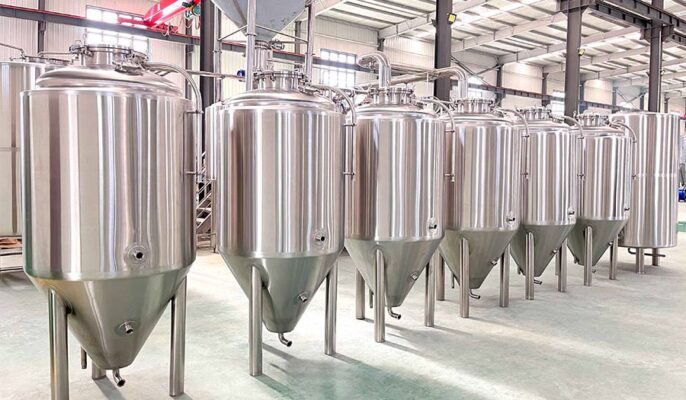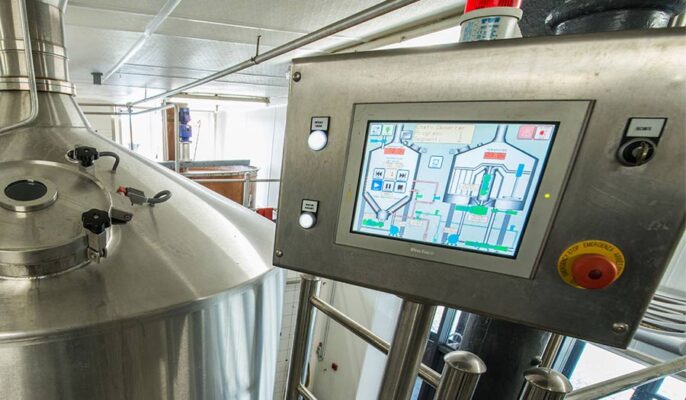O controlo da temperatura é um aspeto fundamental do processo de fabrico de cerveja que desempenha um papel vital na garantia da qualidade e consistência do produto final. Desde a brassagem até à fermentação e acondicionamento, o controlo da temperatura em cada fase do processo de fabrico de cerveja afecta diretamente o sabor, o aroma e as caraterísticas gerais da cerveja ou de outra bebida fabricada. As temperaturas estáveis garantem a consistência do processo de fabrico, reduzem as variações de lote para lote e asseguram que cada garrafa de cerveja tem o sabor e a qualidade esperados.
Porquê controlar a temperatura de fermentação?
O controlo da temperatura de fermentação é, provavelmente, o maior passo para obter o máximo de progresso na produção de cerveja. Em termos simples, a levedura de cerveja típica tem o seu melhor desempenho no intervalo de 66-72°F. Esta é a temperatura ideal para garantir que a levedura faz o seu trabalho sem produzir demasiados sabores indesejados. A levedura prospera em temperaturas mais quentes, mas multiplica-se mais rapidamente e produz mais ésteres no processo.
Sabores estranhos são frequentemente associados a temperaturas de fermentação descontroladas:
- Álcoois Fusel: Muitas vezes percebido como um sabor alcoólico quente que quase sabe a vinho ou vodka, este sabor tende a desaparecer durante o processo de acondicionamento.
- Ésteres: Muitas vezes percebidos como sabores frutados, de banana, pera ou removedor de esmalte de unhas. Embora alguns ésteres sejam bem-vindos em certos estilos, como a cerveja de trigo, muitas vezes atingem-nos quando não deveríamos. Os ésteres diminuem durante o condicionamento, mas uma overdose pode nunca melhorar com o tempo.
- Acetaldeído: Muitas vezes percebido como maçã verde, abóbora crua ou abobrinha. O acetaldeído é um subproduto natural de qualquer fermentação, mas em condições não controladas, pode estar presente em excesso.

Como se consegue o arrefecimento do mosto?
A maioria das fábricas de cerveja arrefece o mosto através de permutadores de calor de placas de fase simples ou dupla. Esta aplicação é exigente; uma grande quantidade de carga térmica deve ser removida do processo. Uma mistura de glicol-água no circuito de água aumenta o efeito de arrefecimento. Os permutadores de calor de parede dupla de qualidade alimentar são frequentemente escolhidos para evitar problemas de contaminação entre o mosto e o líquido de arrefecimento.
Factores a considerar:
- Quantidade total de mosto a arrefecer (normalmente expressa em BBL/barril de volume).
- Tempo de eliminação necessário (tempo de arrefecimento necessário para otimizar o processo).
- Temperatura inicial do mosto e temperatura final desejada do mosto.
- O refrigerador também pode fornecer capacidade de arrefecimento para outros processos de fabrico de cerveja?
O papel do controlo da temperatura no processo de fabrico de cerveja
Esmagamento
Durante a brassagem, os grãos triturados são misturados com água quente para extrair os açúcares fermentáveis e produzir um líquido açucarado chamado mosto. A temperatura durante a brassagem afecta o tipo e a quantidade de açúcares extraídos. As temperaturas mais baixas promovem a produção de mais açúcares fermentáveis, resultando numa cerveja mais seca e mais diluída. As temperaturas mais elevadas favorecem a produção de menos açúcares fermentáveis, resultando numa cerveja mais doce e encorpada. O controlo exato da temperatura é fundamental para que a brassagem atinja a composição desejada do mosto e assegure uma base adequada para o resto do processo de fabrico da cerveja.
Ebulição
Após a brassagem, o mosto é fervido para o esterilizar e o lúpulo é adicionado para lhe conferir amargor, sabor e aroma. A duração e a intensidade do processo de fervura afectam o amargor final e o carácter da cerveja. O controlo da temperatura durante o processo de fervura ajuda a evitar a caramelização excessiva e assegura um perfil de amargor consistente.
Fermentação
A fermentação é uma fase importante em que a levedura consome os açúcares do mosto, produzindo álcool e dióxido de carbono. A temperatura de fermentação afecta significativamente o comportamento da levedura, resultando na produção de vários ésteres e outros compostos de sabor. O controlo da temperatura é fundamental neste caso, uma vez que as diferentes estirpes de levedura têm intervalos de temperatura específicos nos quais têm um melhor desempenho. Temperaturas demasiado altas ou demasiado baixas podem resultar em sabores estranhos, fermentações paradas ou atividade excessiva da levedura, o que pode ter um impacto negativo no sabor e no aroma da cerveja.
Condicionamento
Após a fermentação, a cerveja precisa de ser condicionada para permitir que o sabor amadureça e se desenvolva ainda mais. Durante o processo de condicionamento, o controlo da temperatura é essencial para facilitar as reacções químicas desejadas, incluindo a decomposição de compostos indesejados e a formação de compostos de sabor desejados. O controlo adequado da temperatura garante que a cerveja atinge o perfil de sabor e a clareza desejados.

Porque é que o controlo da temperatura é importante no processo de fermentação da cerveja?
Controlo da temperatura durante a fermentação
Fermentar a cerveja à temperatura correta ajuda a levedura a converter os açúcares em álcool, resultando numa cerveja deliciosa com um sabor forte. Se a temperatura for demasiado alta ou demasiado baixa, a estirpe de levedura pode tornar-se lenta ou morrer completamente, deixando assim de funcionar corretamente.
As temperaturas baixas podem também provocar o aumento da acidez da cerveja, enquanto as temperaturas elevadas podem fazer com que a cerveja produza sabores estranhos, como ésteres e óleos fúsel. Por conseguinte, é muito importante prestar muita atenção à temperatura de fermentação do mosto durante todo o processo de fabrico da cerveja.
Formação do sabor e do aroma da cerveja
A temperatura de fermentação tem um efeito significativo no sabor e no aroma da cerveja. A diferentes temperaturas, os componentes do sabor da cerveja resultante são diferentes. À temperatura correta, a levedura pode converter rápida e completamente os açúcares em álcool e dióxido de carbono, aumentando assim a eficiência e o rendimento da fermentação. Se a temperatura for demasiado elevada, a levedura pode perder atividade devido ao sobreaquecimento; se a temperatura for demasiado baixa, a taxa de fermentação abranda e pode mesmo levar a uma fermentação incompleta. Na produção de cerveja, o controlo da temperatura é crucial para a formação do sabor e do aroma da temperatura. Não só afecta a atividade da cerveja, como também está diretamente relacionado com os vários compostos de sabor produzidos durante o processo de fermentação.
Melhorar a eficiência da produção de cerveja
Ao controlar com precisão a temperatura de fermentação, é possível assegurar a estabilidade e a previsibilidade do processo de fabrico de cerveja, melhorando assim a eficiência da produção e reduzindo os custos de produção. Simultaneamente, os vinhos de alta qualidade podem também trazer maior valor de mercado e benefícios económicos.
Como conseguir um controlo preciso da temperatura?
- Trocadores de calor: Os permutadores de calor são utilizados para arrefecer rapidamente o mosto após a ebulição, parando as reacções enzimáticas e reduzindo o risco de sabores estranhos. Os permutadores de calor de placas ou contracorrente são comuns nas fábricas de cerveja e transferem o calor do mosto quente para a água fria, mantendo os dois separados.
- Controladores de temperatura: Os controladores de temperatura são dispositivos que regulam os tanques de fermentação e controlam a temperatura dos recipientes. Mantêm a temperatura dentro de um intervalo específico, permitindo aos fabricantes de cerveja ajustar o processo de fermentação de acordo com o intervalo de temperatura ideal da levedura. Os controladores de temperatura proporcionam precisão e estabilidade, o que pode reduzir o risco de sabores estranhos ou de estagnação da fermentação.
Conselhos para o controlo da temperatura
Aumento da temperatura de fermentação
- Embrulhe o fermentador num saco de dormir ou num cobertor isolado. Envolver o fermentador bloqueia o calor gerado pela fermentação da levedura, fazendo com que a temperatura aumente.
- Coloque o fermentador numa caixa de cartão ou numa sala isolada para obter um efeito semelhante.
- Outra forma de controlar a temperatura é submergir o fermentador num balde de água e utilizar um aquecedor tipo aquário para manter a temperatura.
Reduzir a temperatura de fermentação
- O método mais simples é envolver o fermentador numa toalha húmida. À medida que a água se evapora, o exterior do fermentador arrefece.
- Se isto não funcionar, pode colocar o fermentador em cerca de 1-2 polegadas de água e envolver o fermentador numa toalha húmida, certificando-se de que a toalha está a tocar na água. Isto proporciona um fornecimento constante de humidade para a evaporação.
- Pode também adicionar cubos de gelo à água ou ligar uma ventoinha para arrefecer ainda mais a água. Também pode submergir o jarro num balde de água e utilizar um saco de gelo para baixar a temperatura. Terá de substituir regularmente o saco de gelo para manter uma temperatura constante.

FAQ
Porque é que a temperatura deve ser controlada durante o processo de fermentação?
Durante o processo de fermentação, a temperatura é um fator chave que afecta a atividade dos microrganismos, a taxa metabólica e a qualidade dos produtos de fermentação. Diferentes microrganismos têm os seus intervalos óptimos de crescimento e de temperatura de fermentação. Só a uma temperatura adequada é que os microrganismos se podem reproduzir rapidamente e converter eficazmente os substratos nos produtos desejados.
Como determinar a temperatura ideal durante o processo de fermentação?
Para determinar a temperatura óptima durante o processo de fermentação, é necessário ter em conta muitos factores, incluindo as espécies microbianas, as caraterísticas do substrato, as condições do processo de fermentação, etc.
Como conseguir um controlo preciso da temperatura de fermentação?
Para conseguir um controlo preciso da temperatura de fermentação, é necessário equipamento e tecnologia avançados de controlo da temperatura. O equipamento comum de controlo da temperatura inclui incubadoras de temperatura constante, tanques de fermentação, etc. Estes dispositivos estão normalmente equipados com sensores de temperatura precisos e sistemas de controlo, que podem monitorizar e ajustar a temperatura do líquido de fermentação em tempo real.




